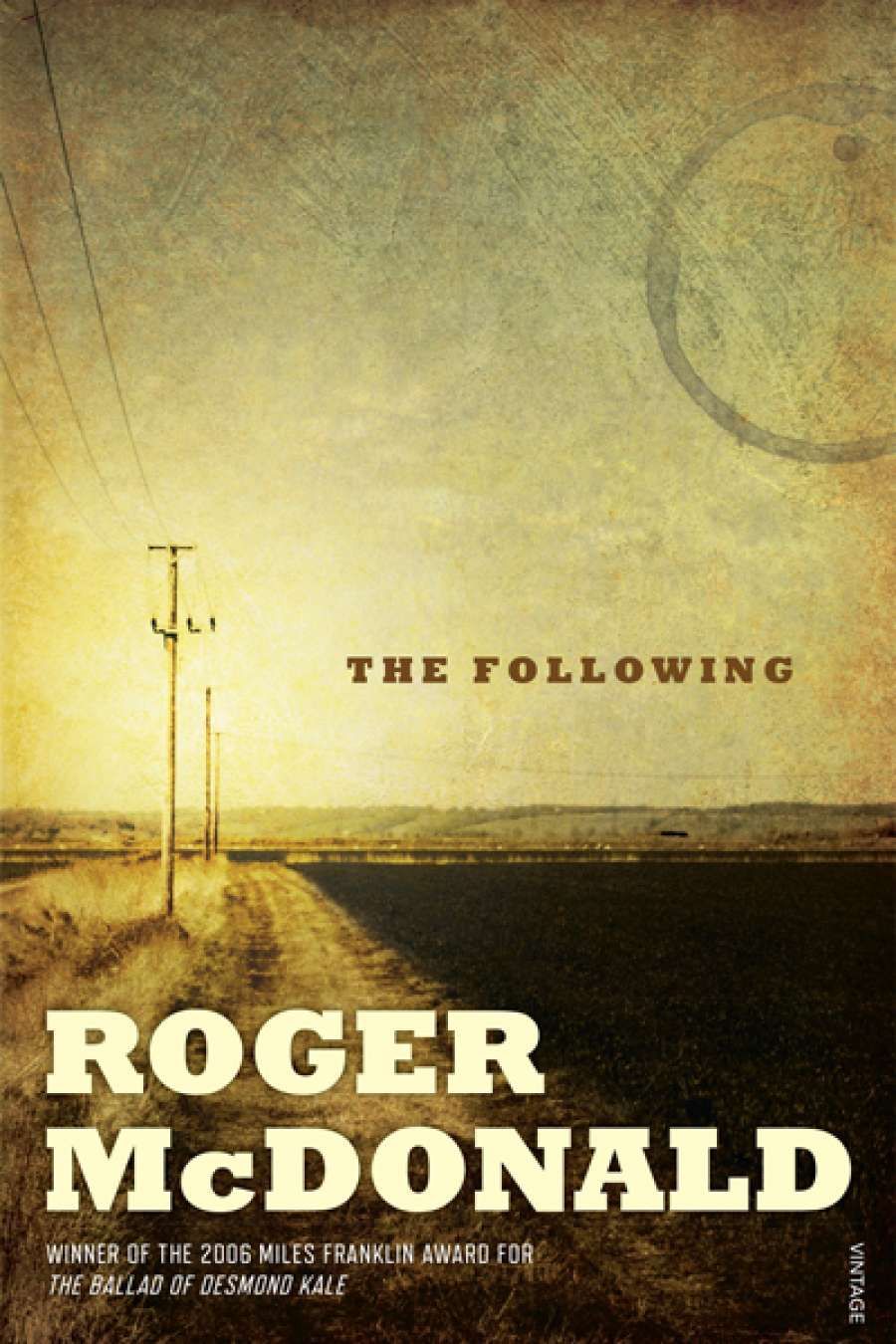
- Free Article: No
- Contents Category: Fiction
- Custom Article Title: Don Anderson reviews 'The Following'
- Review Article: Yes
- Article Title: Print the legend
- Online Only: No
- Custom Highlight Text:
Towards the end of Saul Bellow’s Humboldt’s Gift (1975), at the poet Von Humboldt Fleisher’s funeral on an April day in Chicago, Menasha Klinger, one of three mourners, points to a spring flower and asks Charlie Citrine, the novel’s narrator, to identify it. ‘Search me,’ Citrine replies, ‘I’m a city boy myself. They must be crocuses.’ This exchange has stayed with me for some thirty-five years. I, too, am a city boy, and couldn’t identify a crocus if I saw one.
- Book 1 Title: The Following
- Book 1 Biblio: Vintage, $32.95 pb, 263 pp, 9781742759913
Miles Franklin Award-winning novelist Roger McDonald is, on the other hand, a country boy. He is one of two eminent Australian writers I have met whose deep red forearms and face betray his life on the land. (The other was David Campbell.) Roger McDonald’s interest in rural living derives from his childhood in Young, New South Wales. He went to primary school in Temora and now lives on a farm outside Braidwood, between Canberra and Batemans Bay. At the 2006 census, Braidwood had a population of 1108, about the same as the Darlinghurst block where I live. McDonald has two brothers, both of whom became farmers in Queensland (one later farmed in New Zealand). He suggests that all three may be seen ‘as part of the same impulse. Some sort of primary production, entirely bound up in common ground.’ Autochthonous, you might say.
In an author’s note appended to this poetic, moving, essentially rural novel, we are told:
Assembled with my schoolmates in the playground of Temora Public School on the 17th of October 1949 I heard the voice of the Prime Minister, Ben Chifley, on the radio, at the launch of the Snowy Mountains Scheme and assumed that he was the one who pushed the explosives plunger and made the loudspeakers on the classroom verandah ruffle so memorably. But history tells me otherwise: it was the Governor-General, Sir William McKell, who pushed the plunger – and so Book One of The Following, derived from that echo, is owed to a ghost of Ben Chifley, with apologies to the real one. Likewise, throughout this book, it is a ghost of Labor not Labor itself providing a focus of spiritual attachment.
In this novel, the fictionalised Ben Chifley is depicted as Marcus Friendly:
Friendly spoke about rebuilding the nation to make it last, that he would move mountains to do so. To Ross [Devlin] it was literally proved. While the whole country listened on the ABC, Marcus Friendly had pressed the plunger on the first big explosives charge in the Snowies in ’49. It was, at the time, a momentous impression the bloke made on a kid as Ross stood in the school playground, watching the speakers of three portable amplifiers ruffle as the blast went off.
It was, of course, the Chifley government that conceived of the Snowy Mountains Scheme. Thus fiction redresses fact. As the newspaper editor, played by Edmond O’Brien, says in John Ford’s The Man Who Shot Liberty Valance (1962), ‘When history conflicts with the legend, print the legend.’
Thus The Following is a fictional account of aspects of the career of Ben Chifley, Australia’s sixteenth prime minister (1945–49), and his followers over the next two generations. It might be read as a celebration of older, rural, working-class virtues. McDonald is perfectly entitled to fictionalise history, notwithstanding that this approach has been the topic of passionate debate and dissent in Australia in recent years (recall Inga Clendinnen, Kate Grenville, and others). But even in a work of fiction, errors of fact may occur. Or can and should they? What are the relations between fiction and history, or ‘Dichtung und Wahrheit’, as Goethe put it (and Von Humboldt Fleisher would insist upon alluding). Consider this passage from The Following:
Powys showed her a photograph of his mother in St Vincent’s attended by Sisters of Mercy hoping for a conversion. … Lady Wignall was like a she-bear in a cave with her furs and claw clasps, sitting up drinking Dom Pérignon between Irish nuns.
Now, I speak with the authority of one who has drunk Moët et Chandon in St Vincent’s on my birthday a few years back, but I beg to point out that this distinguished hospital was founded and is managed by the Sisters of Charity. As an eminent Australian Catholic historian muttered when I checked with him: ‘What is wrong with our school system?’ Courtesy requires that the Sisters of Charity be acknowledged as the angels of St Vincent’s Hospital and Hospice, Darlinghurst. So there is an ongoing tension between Poetry and Truth.
None of which should be taken to imply that The Following is neither poetic nor truthful. It is persuasively both. As Powys, who may somehow reflect Patrick White, ruminates: ‘All was spirit and he chased it down with words. Words were his saving grace.’


Comments powered by CComment